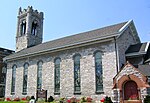Hagerstown Historic District
Hagerstown, MarylandHistoric districts in Washington County, MarylandHistoric districts on the National Register of Historic Places in MarylandNRHP infobox with nocatNational Register of Historic Places in Washington County, Maryland ... and 2 more
Use mdy dates from August 2023Washington County, Maryland Registered Historic Place stubs

Hagerstown Historic District is a national historic district at Hagerstown, Washington County, Maryland, United States. The district contains the downtown commercial and governmental center as well as several surrounding urban residential neighborhoods and industrial areas. It includes the original plat of Hagerstown, laid out in the 1760s, as well as areas of expansion that developed generally prior to or just after the turn of the 20th century. Some 2,500 Confederate dead lie in Rose Hill Cemetery on South Potomac Street, most of whom died at the Battle of Antietam.It was added to the National Register of Historic Places in 1994.
Excerpt from the Wikipedia article Hagerstown Historic District (License: CC BY-SA 3.0, Authors, Images).Hagerstown Historic District
South Locust Street, Hagerstown
Geographical coordinates (GPS) Address Nearby Places Show on map
Geographical coordinates (GPS)
| Latitude | Longitude |
|---|---|
| N 39.639722222222 ° | E -77.718333333333 ° |
Address
South Locust Street 56
21740 Hagerstown
Maryland, United States
Open on Google Maps









